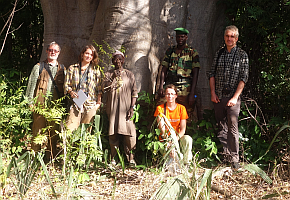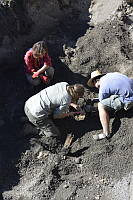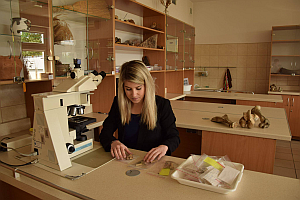Phytolith analysis
Phytoliths are microscopic particles of minerals that form in plants. The subsequent decay of the plants releases phytoliths into the soils. An analysis of the phytoliths from cultural and natural contexts yields information on both plant use by people and the natural vegetation of an area. Our laboratory explores the application of phytolith analysis for archaeobotanical and palaeoecological research in the Czech Republic. At present, we are building up a reference collection for Central Europe. Our analyses have included archaeological sediments and stratigraphic profiles.
Phytolith analysis in more detail:
Solid deposits of SiO2 form in many plants at specific intracellular ond/or extracellular locations. These deposits, as well as other types of plant mineral deposits, are called phytoliths, literally meaning "plant-rocks". Many plant taxa produce phytoliths with characteristic morphologies, giving them taxonomic significance. Phytoliths are released from plants when the plant tissue in which they formed decays, is burned, or is digested. When the plant dies, the three-dimensional copies of the plant cells are left intact, and can remain intact and recognizable for long periods of time in most conditions. After incorporation into the soil, only highly alkaline or acidic soil reaction enhances their dissolution. Phytoliths thus become microfossils of the plant that produced them. The high heat-resistance of phytoliths enables them for instance to be preserved in fireplaces.
The potential of phytolith analysis Greater experience with the phytolith taxonomy of present-day plants enables researchers to detect some plant taxa in archaeological sediments based on silica microfossils. The most studied phytolith assemblages come from Central and South America (Piperno 1998a, 1998b; Piperno et Becker 1996; Piperno et al 2000; Piperno et al 2001), North America (McClaran 2000, Fearn 1998, Fredlund et Tieszen 1997, Bozarth 1992, Brown 1984), tropical Africa (Mercader et al 2000, Runge 1999, Barboni et al 1999), New Zealand (Carter 2000, Horrocks et al 2000), the Near East (Rosen 1992), and South-East Asia (Kealhofer et al 1999, Kealhofer et Penny 1998, Zhao et al 1998).
Phytoliths are invaluable in archaeology for the detection of cereals (the grass family is an abundant phytolith producer) and other subsistence plants, eg. maize and squash in America (Pearsall 1978, Piperno 1984, Piperno et al 2000, Piperno et Flannery 2001), rice in Asia (Jiang 1995, Whang et al 1998, Zhao et al 1998, Huang et Zhang 2000), and cereals of the Old World (Rosen 1992, Ball et al 1999, Ball et al 1996, Kaplan et al 1992). Though phytolith analysis has an enormous potential, identification using phytoliths is complex and difficult to apply at refined levels of taxonomy.
Phytoliths are versatile fossils. They may be directly dated using either radiocarbon (Mulholland 1993, Kelly et al. 1991, McClaran et Umlauf 2000) or thermoluminescence (Rowlett et Pearsall 1993), may serve as direct idicators of the past burning of vegetation, can be chemically analyzed to yield stable isotope ratios of carbon, hydrogene, and oxygen (Fredlund 1993, Kelly et al. 1991), and provide data concerning the functional uses of artifacts. Phytoliths recovered from archaeological sites allow the identification of gathered or grown foods, the plants used to build shelters, and the vegetation growing on and around the site.
A general review of phytolith production in different plant taxa is given by Deborah Pearsall on the web site of the University of Missouri Paleoethnobotany Laboratory. The compilations are intended to convey general patterns of phytolith production by order, family, and genus.



